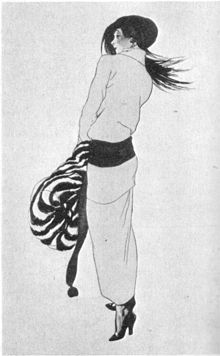 The extravagances of the Parisian couturiers came in a variety of shapes, but the most popular silhouette throughout the decade was the tunic over a long underskirt. Early in the period, waistlines were high (just below the bust), echoing the Empire or Diréctoire styles of the early 19th century. Full, hip length "lampshade" tunics were worn over narrow, draped skirts. By 1914, skirts were widest at the hips and very narrow at the ankle. These hobble skirts made long strides impossible.[2]
The extravagances of the Parisian couturiers came in a variety of shapes, but the most popular silhouette throughout the decade was the tunic over a long underskirt. Early in the period, waistlines were high (just below the bust), echoing the Empire or Diréctoire styles of the early 19th century. Full, hip length "lampshade" tunics were worn over narrow, draped skirts. By 1914, skirts were widest at the hips and very narrow at the ankle. These hobble skirts made long strides impossible.[2]Waistlines were loose and softly defined. They gradually dropped to near the natural waist by mid-decade, where they were to remain through the war years. Tunics became longer and underskirts fuller and shorter. By 1916 women were wearing a calf-length dress over an ankle-length underskirt.
When the Paris fashion houses reopened after the war, styles for 1919 showed a lowered and even more undefined waist.


0 comments:
Post a Comment